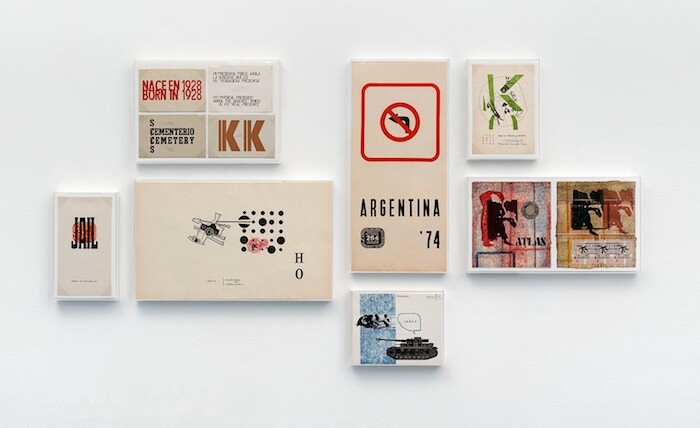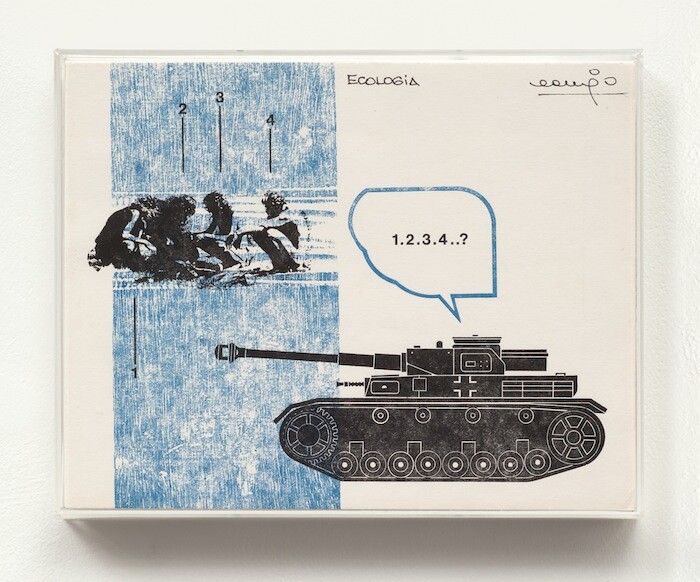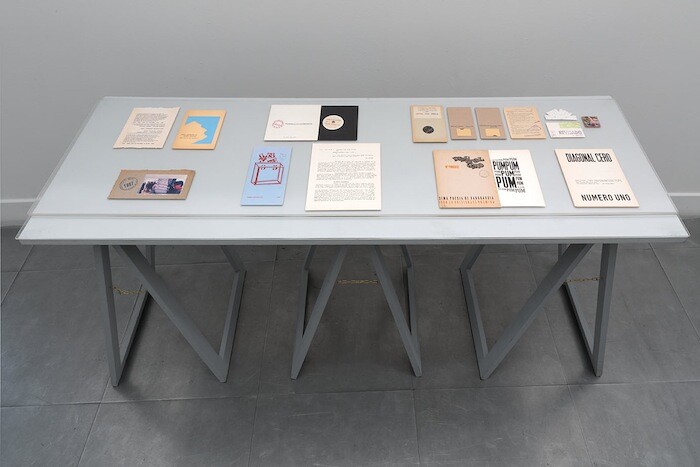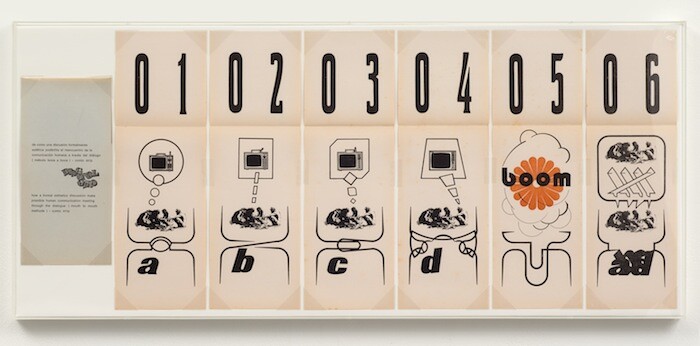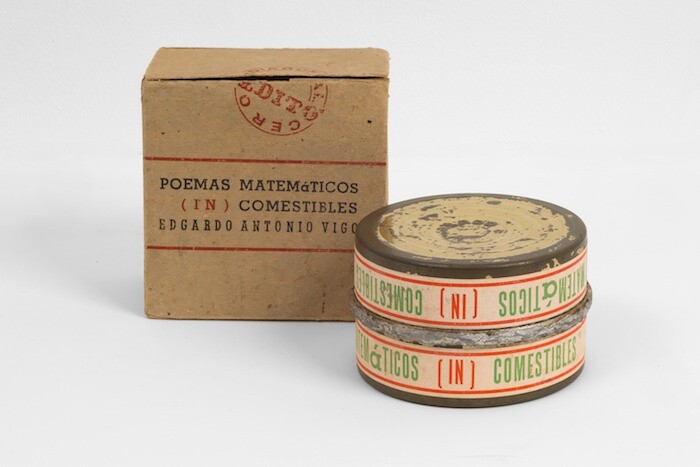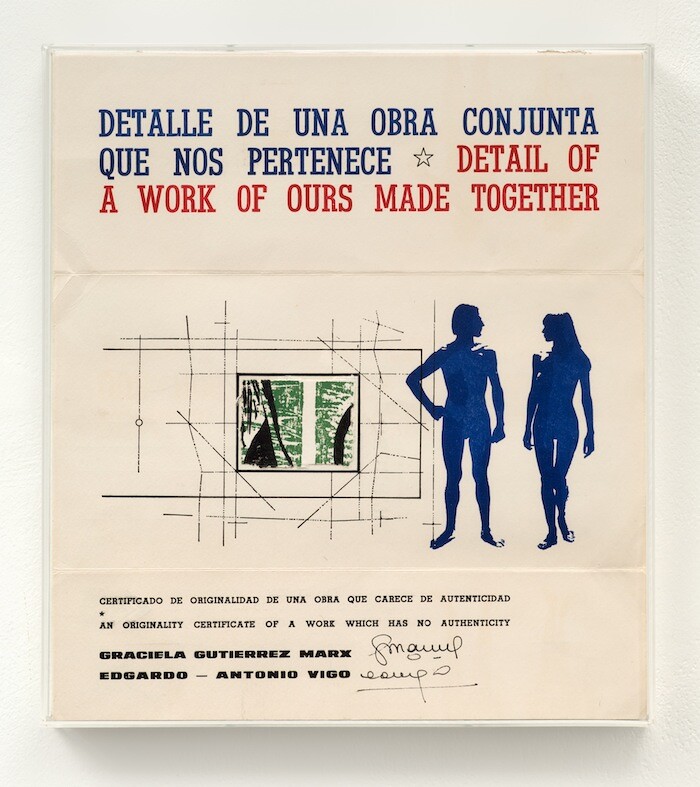“Un Arte A Realizar [An Art In Becoming]” is the first solo exhibition in the UK dedicated to the Argentinian artist Edgardo Antonio Vigo, who died in 1997. Relatively unknown in Europe, his name has until recently been associated with mail art, that most underrated of avant-garde movements. The exhibition presents a small selection of around 30 works, mostly on paper, from the late 1950s to the ’90s, part of a much larger collection recently acquired by the gallery from the Sackner Archive of Concrete and Visual Poetry in Miami.1
Vigo’s early work comprises concrete poetry, represented here by two 1958 prints (R and Composición mecánico-estética), and neo-dada objects, which he defined as useless and impossible machines.2 (Photographs documenting two of these are on display.) He edited the artists’ magazine Diagonal Cero, which featured visual and concrete poetry from Argentina and beyond, and in 1969 organized the international exhibition of concrete poetry “Expo Internacional Novísima Poesía/69” in Buenos Aires. Between 1971 and 1975 he published Hexágono ’71, a magazine that included contributions from a wide range of international artists. Although these publications are poorly represented in the exhibition—with just two issues of Diagonal Cero—they are central to Vigo’s practice, and their presence is felt behind and between the framed prints displayed on the walls of the gallery.
From 1968, with Manojo de semáforos [Handful of traffic lights], Vigo started a series of conceptual performances, often involving the audience, that would continue for the rest of his career. Documentation of his conceptual work is included at Richard Saltoun with the series “El Tapón del Río de la Plata” [River Plate’s plug] (1973). The Manzonian multiple Poemas matemáticos (in)comestibles [(in)edible mathematical poems], the only sculptural work in the exhibition, was also made in 1968.
Vigo’s practice would become more explicitly political during the 1970s (his son, Abel Luis, was “disappeared” under the military regime in 1976), primarily taking the form of mail art. An active mail artist, with many international connections (some of the material displayed retains the Sackners’ address, stamps, and postmarks), he co-organized the pioneering exhibition “Última Exposición de Arte Correo” [Last Mail Art Exhibition] in Buenos Aires in 1975. His mail art is characterized by a desire to establish independent chains of communication between individuals and groups to address social, political, and economic concerns while, at the same time, privileging craft and experimentation with material, color, and construction.
Vigo’s important role in the development of neo-avantgarde art practices in Argentina in the 1960s and ’70s, and his wider influence and connections, are only now becoming better understood thanks to new academic research and exhibitions, large and small, on both sides of the Atlantic (Museo de Arte Moderno in Buenos Aires, 2016; Museum of Modern Art, New York, 2014; Weserburg Museum of Modern Art, Bremen, 2012). His work, from performance to xerox, addresses a wider context of his rejection of traditional media, the gallery system, and the art market. His significant involvement with concrete poetry3—a meeting place of literature and visual arts—locates him at an early phase of the turn to language that characterized conceptual art.
Vigo (“el borde Vigo,” as he signs himself in a work in this show) is slowly moving in from the margins as part of a much-needed, ongoing review of historical narratives of 1960s art that includes the reassessment of the significance of concrete poetry, mail art, and other neo-avantgarde forms. “Un arte a realizar [An Art In Becoming]” makes a small but useful contribution to this debate, presenting a career-long selection of Vigo’s work to new audiences.4
Some of this material was also presented at ARCO in Madrid, in February 2017.
See Edgardo Antonio Vigo, Maquinaciones. Edgardo Antonio Vigo: trabajos 1953-1962 (Buenos Aires: CCEBA, 2008).
Vigo’s object-poems are included, for instance, in The Oxford Book of Latin American Poetry (Oxford: Oxford University Press, 2009).
While we wait for a much needed, up-to-date monograph on Vigo (one was announced for “Edgardo Antonio Vigo: Obras 1953 – 1997,” a large retrospective held last year at the Museo de Arte Moderno in Buenos Aires, but has not yet been published), Richard Saltoun has produced a small catalogue to accompany this exhibition.


